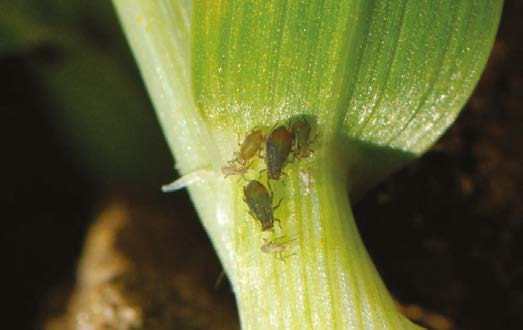- Home
- Knowledge library
- Basic biology of the bird cherry–oat aphid
Basic biology of the bird cherry–oat aphid
Bird cherry–oat aphid (Rhopalosiphum padi) is an important vector of Barley yellow dwarf virus (BYDV) in cereals. Learn about its life cycle and the key features to help you identify it.
Virus management in cereals and oilseed rape
Bugs and thrips encyclopaedia home
Understanding aphid biology
Initially, aphids colonise relatively few crop plants. However, the second generation tends to move away from the plant originally colonised. Controlling this generation is a key part of a BYDV management strategy.
Life cycle and identification
The wingless adult aphids are 1–2 mm long, broadly oval-shaped and green-to-dusky brown, with rust-red patches at the rear. Winged adults are a similar size, with a pale-to-dark green abdomen and similar rust-red patches.
- Dec–Mar: Eggs overwinter on bird cherry trees (Prunus padus).
- Apr: Eggs hatch.
- May–Jun: Winged forms migrate to cereals and grasses.
- Jul–Aug: Multiple generations occur, infesting lower leaves and stems first.
- Sep–Nov: Winged forms migrate back to bird cherry trees. In mild conditions, asexual forms can remain and feed in cereal crops.
Note: Approximate months shown.
 life cycle (cereal disease).PNG) AHDB
AHDB
Air temperature influences aphid activity. Models can predict the speed at which aphids will multiply. The critical second generation is likely to be present when accumulated daily air temperatures, above a baseline temperature of 3ºC, reach 170 – the temperature sum (T-Sum) value. T-Sum calculations should start either:
- On the day of crop emergence.
- Following a pyrethroid application (account for product persistence, see label).
In most years, aphid flights stop when temperatures drop below about 11ºC.
 Dewar Crop Protection
Dewar Crop Protection

